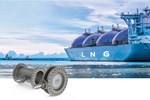The müller co-ax Group is a global manufacturer of valve technology for the most demanding customers and markets. With the founding of müller quadax gmbh almost two years ago, the group of companies has spun off the field of butterfly valves for extreme conditions into a separate company. The four offset butterfly valve QUADAX® is designed for extreme pressure and temperature ranges and is therefore particularly suitable for low-temperature applications such as LNG and cryogenic use.
Natural gas is a fossil fuel and is usually discovered when searching for oil, which forms underground under comparable conditions. After being processed in refineries, storage and transport are carried out by seagoing vessels, tank trucks, tank farms and pipelines. Natural gas condenses to a liquid when it is cooled down to around -162 ° C. The term for this is LNG, which stands for “Liquefied Natural Gas”. This method has considerable advantages over traditional transport options, and is increasingly used in the industry. The volume of the gas is reduced by a factor of around 600 when changing the state of aggregation, allowing the capacity to be used much more effectively. This is far more economical because significantly larger loads can be moved or stored with the same capacity. In addition, there are regions on earth where the construction of pipelines is not possible or the network is only rudimentary. This may be due to factors such as massive geological obstacles or nature reserves. Also, in some cases, the benefit does not justify the high construction costs. In these areas, natural gas can be supplied in larger quantities using LNG technology. Wherever prices for using existing pipelines increase seasonally, LNG can be stored and then transported during off-peak periods.
A steadily growing market
In response to the demand for valves for these and other extreme applications, müller quadax has upgraded its operations. This strategy is paying off and sales have increased significantly year on year. Thanks to the growth potential, especially for liquefied natural gas, CEO Patrick Hofacker is optimistic about the future: “This market is growing rapidly and is becoming more and more important. We have invested heavily – among other things in the expansion of international sales, marketing, enhanced specification work and in our high level of competence as a problem solver. And this is now reflected in the increased sales figures.” In the end, of course, it comes down to the performance of the product itself, which is why Patrick Hofacker emphasises the benefits of the quadax development: “Our four offset butterfly valve has been specifically developed for LNG and cryogenic processes. Thanks to the perfectly round sealing geometry, even temperatures of up to minus 196° C present no problem – even at the most extreme pressures.” In 2018 müller quadax handled two major LNG projects that contributed significantly to the sales development.
four offset butterfly valves
In contrast to the elliptical sealing geometry of a triple offset butterfly valve, the Quadax® operates with a completely round seal. This principle of the four offset design guarantees bubble-free tightness in cryogenic applications and wherever there are massive fluctuations in temperature. During rapid cooling, for example when liquid gas is pumped through a pipeline, the round sealing geometry ensures a tightness of 100%. In the test, müller quadax achieved leakage values better than the target in the valve specification guideline “BS 6364”. They were given the rating: “No visible leakage” (target: 100 mm3 / s * 300 = 30,000 mm3 / s = 1,800 ml / min). In conclusion it can be said that rethinking and retooling to the higher standard is definitely worthwhile and more than profitable within a manageable time frame. With the four offset butterfly valve, costly downtime can be reduced to a minimum and maintenance intervals can be planned more generously.


